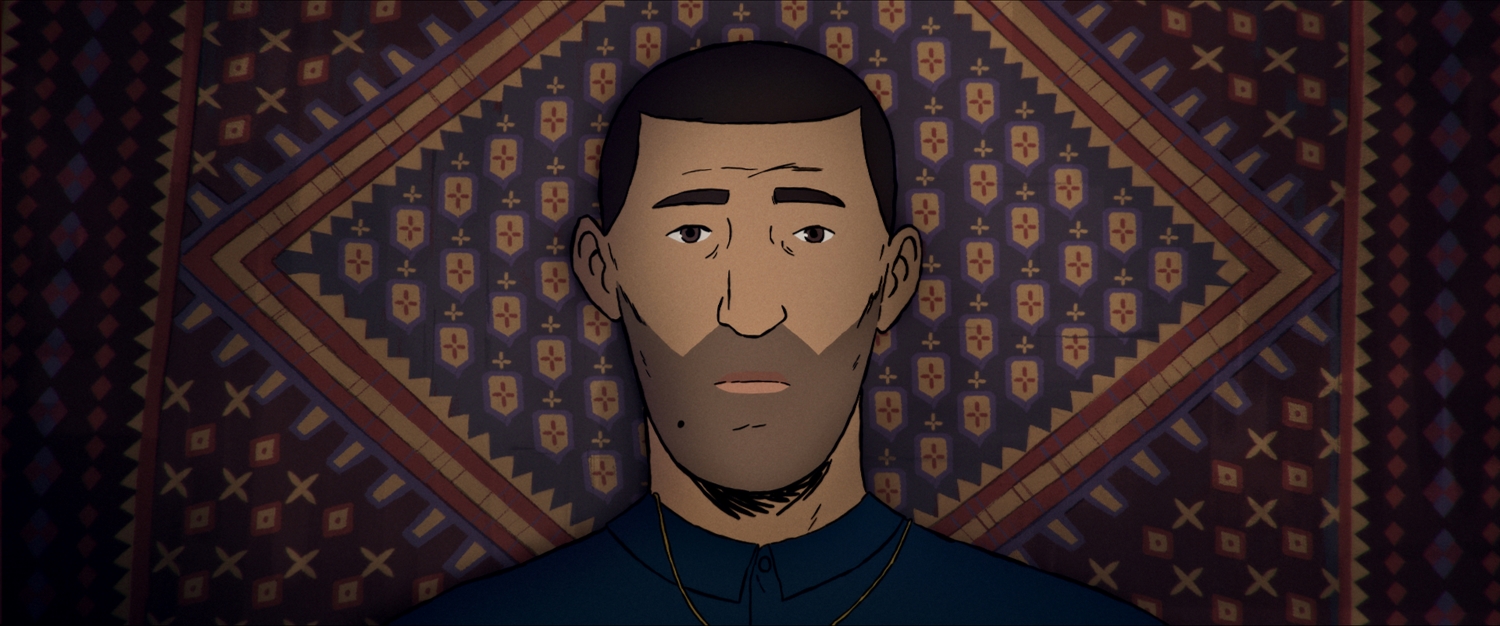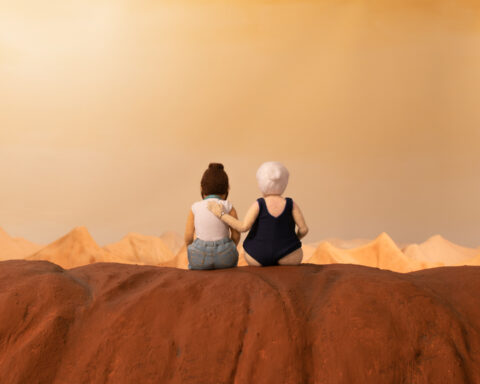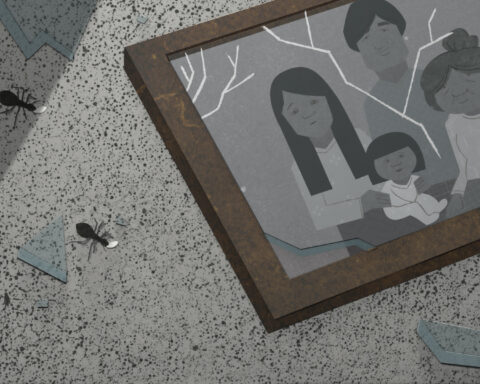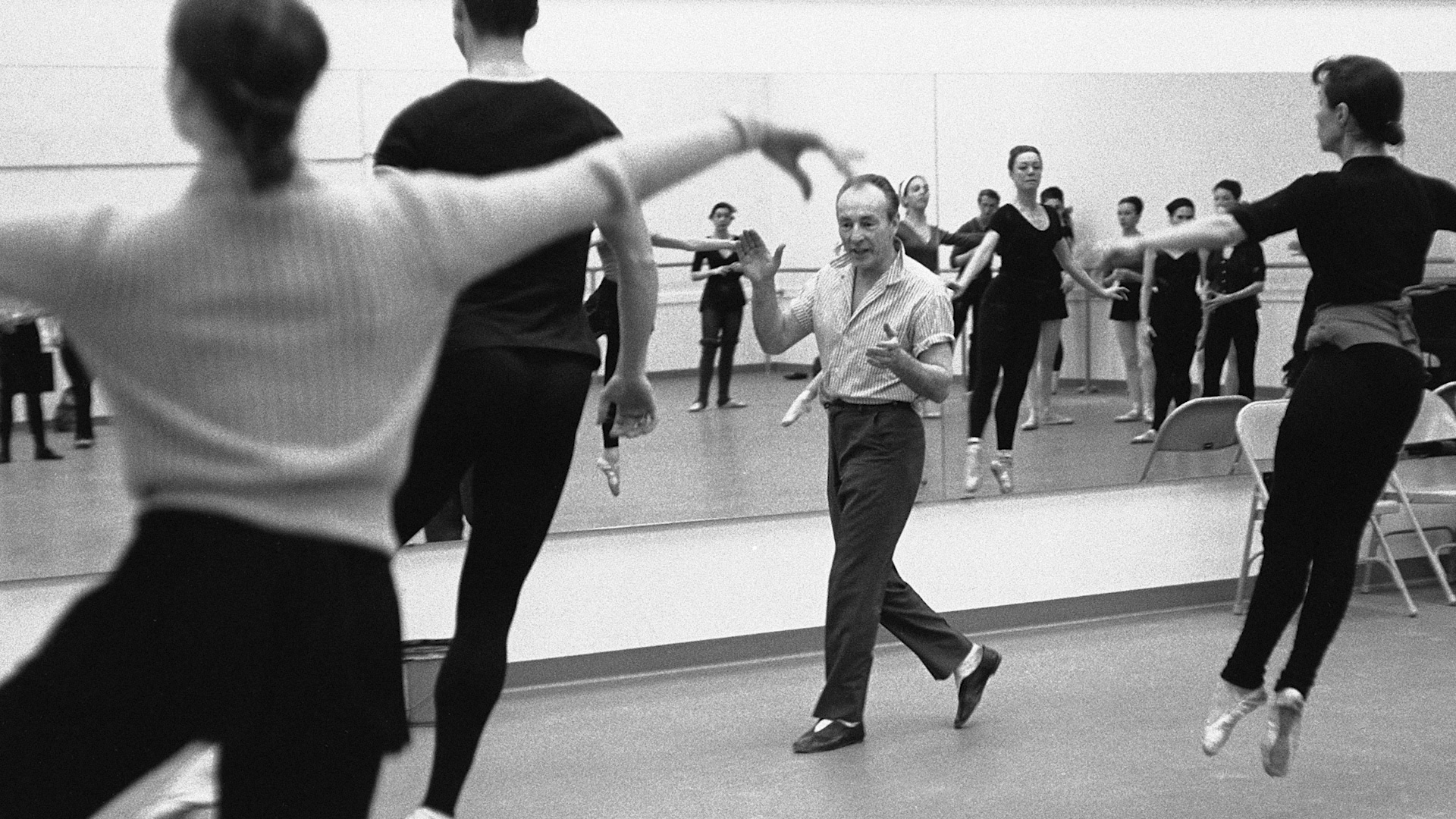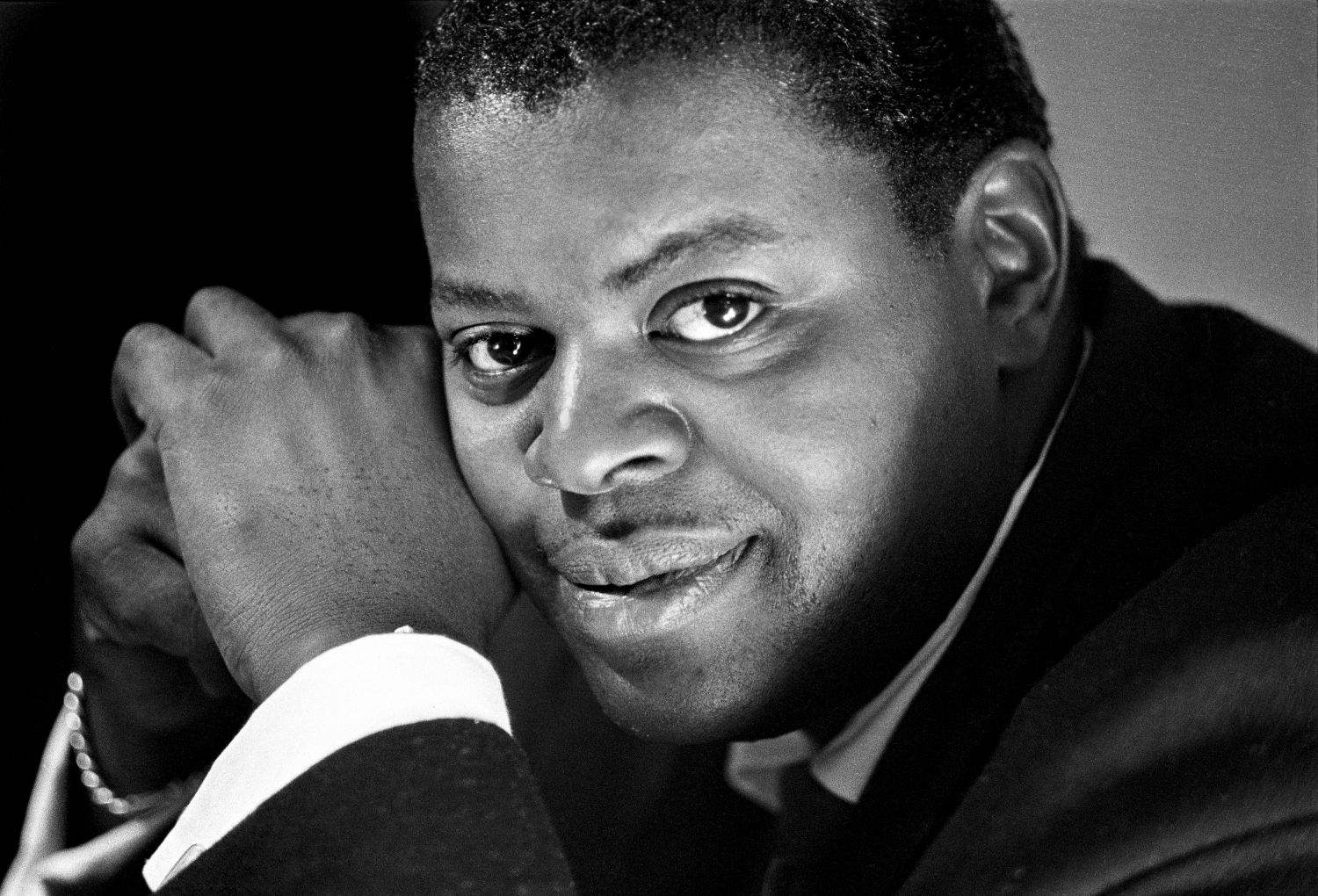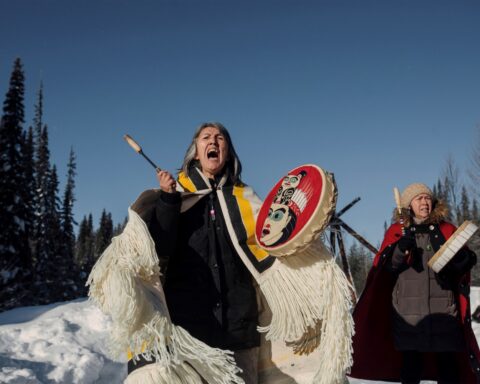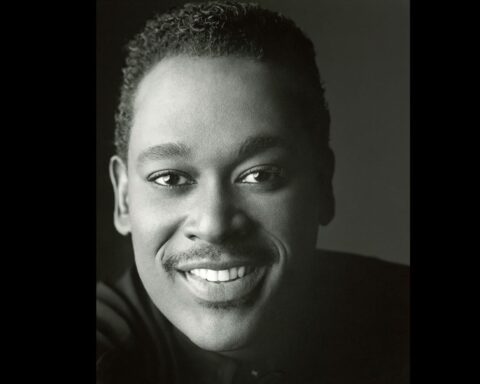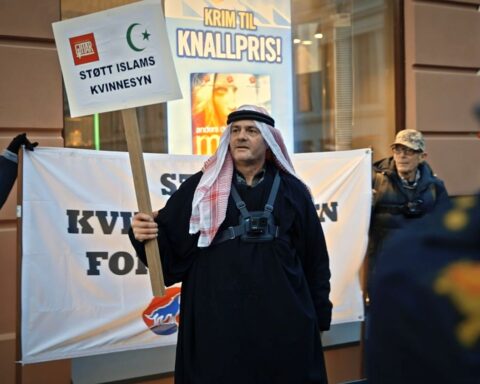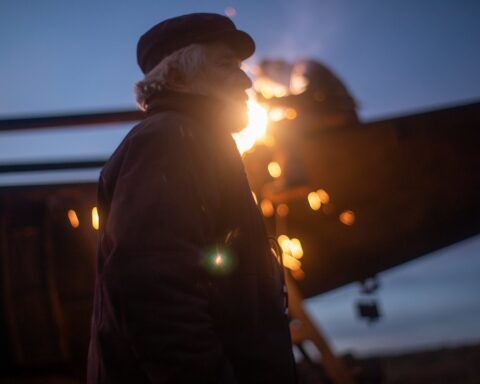“What I learned from Amin’s story is how long shadows can be,” observes Jonas Poher Rasmussen. “These experiences grow into your life and affect you in the years after. That is something you can’t see in people. You can’t see what they carry.”
Rasmussen brings the unseen weight of trauma to the screen in Flee. The Danish-French director, speaking with POV during the Toronto International Film Festival where Flee was a runner-up for the People’s Choice Award for documentary after scoring the Grand Jury Prize at Sundance, recounts a journey though which he helped a friend escape his shadows. Flee shares the experience of Rasmussen’s friend, renamed Amin Nawabi in the film, as he unburdens himself of the story of his escape from Afghanistan during the 1990s amid the reign of the mujahideen. Using animation and voiceover, Rasmussen chronicles Amin’s plight in gripping detail as his friend unspools the perilous journey in which his family were relocated to Moscow by human traffickers. But Flee is a story of a life always on the run, as Amin recounts his second and third journeys, coming out as a gay man—no easy secret in his conservative family trapped in a largely anti-LGBTQ Russia—and then moving to a more understanding Danish society, where, as an Afghan Muslim, he still felt isolated.
For some people, camouflaging one’s identity can be as easy as throwing on a plaid shirt and dumpy jeans and checking one’s speech and mannerisms to present as straight. For others, passing is not so easy. Especially for outsiders in foreign lands, Flee illustrates how race, ethnicity, sexuality, and religion can compound the burdens one carries. As the film interprets Amin’s story through its confessional animated odyssey, Flee explores the intersections of identity and the respective weights and freedoms they bring.
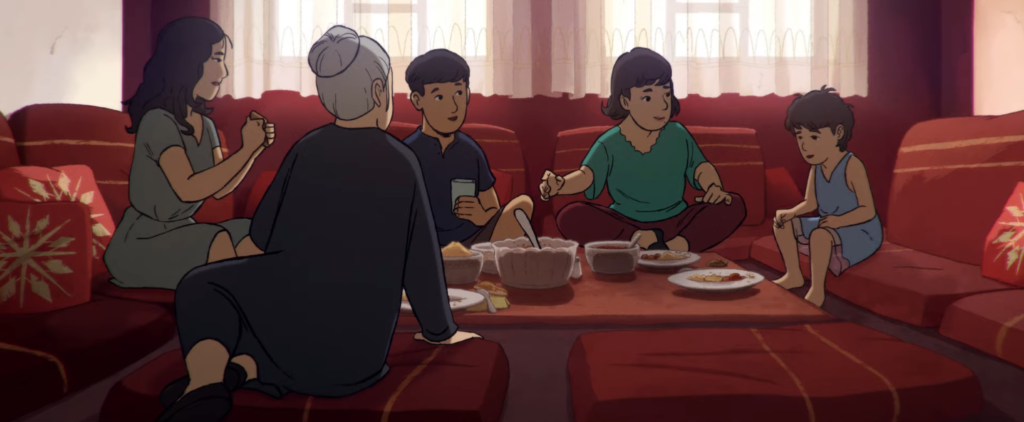
Flee puts audiences in Amin’s headspace as his narration conveys the experience of a life in which one is always looking over one’s shoulder. By sharing his story through an animated lens, Flee demonstrates the potential for intimate, collaborative, and empathetic approaches to non-fiction storytelling. Amin’s story is specific, yet told in such an accessible and subjective way that audiences of diverse backgrounds and experiences can feel seen in the images that Flee poetically conveys.
Flee draws upon the intimacy that Rasmussen and Amin developed over two decades of friendship before working together on the film. It taps into the palpable burden that Rasmussen recognized in Amin the day they met. “I wanted to do a story about my friend and I could see he had something that he needed to cope with,” explains Rasmussen.
The director appears in the present-day scenes of Flee—animated with a blond hairdo, because why not make yourself look like Brad Pitt if you can?—as he interviews Amin and interacts with him as a friend. He appears briefly in the past scenes as his teenage self meets Amin on the bus in their small Danish town. They discuss how Amin hid his past from his friends—Rasmussen only learns of Amin’s family during the interview—and that conversation fuels the film’s interrogation of flight.

However, Rasmussen observes that Amin knew he couldn’t run away from his story forever. “Around fifteen years ago, I asked him if we could do a radio documentary about his story,” explains Rasmussen, who has a background in radio. “He said that he wasn’t ready to tell it, but he knew that he would have to at some point. He said that when he was ready, he would tell it to me, but he needed some more time.”
Then in 2012, Rasmussen says he attended the AniDocs conference at the Denmark Animation School, which convened documentary filmmakers and animators to explore creative approaches to non-fiction filmmaking. Rasmussen notes that the event sparked an idea that combined his background in radio with animation, which would offer a safe space for Amin to tell his story. He cites Ari Folman’s Waltz with Bashir (2008) as an obvious influence in terms of how a documentary could explore trauma through animation, but he says Joshua Oppenheimer’s The Act of Killing (2012) was further inspiration for the creative potential to open up a difficult story. (Killing producer Signe Byrge Sørensen is among Flee’s producers.) Like The Act of Killing, Flee derives higher truths by stepping back from an objective presentation of reality.
“Animation enabled us to make Amin anonymous because it was his first time telling his story,” notes Rasmussen. “It’s a traumatic story and they’re his secrets. He didn’t want people he met on the street to know everything about him. This approach lets him meet people with a clean state and then open up when he feels like it. He needed to be anonymous and this really was the way to do it.”
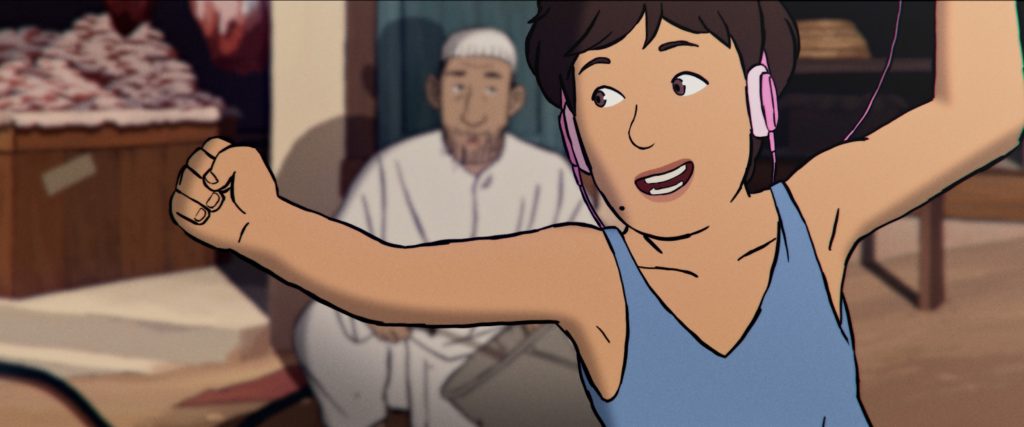
Amin’s audio interview serves as a foundation for the animated visuals, much like Folman used audio interviews as the basis for Waltz with Bashir, with animation filling the space onscreen. One sees a similar process in creative docs like Rithy Pahn’s claymation consideration of the Cambodian genocide in The Missing Picture (2013) or Keith Maitland’s rotoscoped and re-enacted school shooting doc Tower (2016). What distinguishes Flee from these films is that the minimization of traditional documentary visuals—archive, talking heads, observational footage—is more a personal choice than a practical one substituting for the absence of material. (Waltz with Bashir, notably, had a live-action shoot that informed the animation.)
In Flee, the function of animation is twofold. On one hand, it’s an aesthetic vehicle with which to tell the story; on the other hand, it poignantly creates a safe space for Amin while reminding audiences of the fleeting nature of human rights. Twenty years after escaping the mujahideen, gay men like Amin know their rights can easily vanish as political winds change.
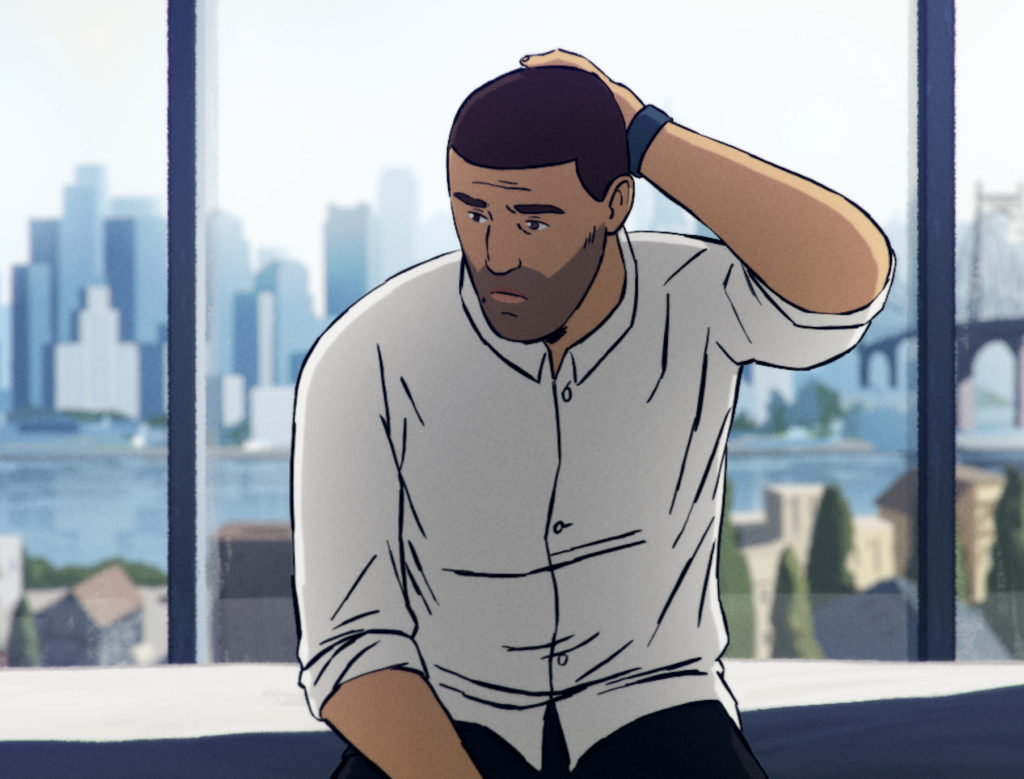 Preserving a subject’s anonymity in a doc obviously isn’t new. However, there’s a difference between Banksy shrouding himself in a tightly drawn hoodie and Amin cloaking himself through animation. Nobody aside from Rasmussen, Amin, Amin’s partner, and a few peers can even know if he looks anything like his animated counterpart. Judging from the perfectly handsome Rasmussen’s differing appearances in the film and in our Zoom interview, Amin is highly unlikely to be an identical twin to his character in Flee.
Preserving a subject’s anonymity in a doc obviously isn’t new. However, there’s a difference between Banksy shrouding himself in a tightly drawn hoodie and Amin cloaking himself through animation. Nobody aside from Rasmussen, Amin, Amin’s partner, and a few peers can even know if he looks anything like his animated counterpart. Judging from the perfectly handsome Rasmussen’s differing appearances in the film and in our Zoom interview, Amin is highly unlikely to be an identical twin to his character in Flee.
Flee demonstrates its structure to viewers at the beginning as Rasmussen has Amin lie on his back and shimmy into place. He then adjusts himself beneath a camera that the director mounts overhead. Shooting Amin’s interview in close-up, Rasmussen draws upon a technique from his radio work in which interviewees reclined and described the past to evoke the sights, sounds, and smells that transport them through memories. Amin closes his eyes, and memories flow back to him. One sees Amin unburden himself as Flee transports audiences through his journey.
Rasmussen says that the process of streamlining several days’ worth of interviews was a collaborative effort to ensure authenticity. “First, I did the interviews, and then I made a selection of what I wanted in the film and made a script,” explains Rasmussen. “Amin then read that and fact-checked it. If I removed things he thought were key to understanding his story, then we would have conversations about them and, of course, would then change things around.” Overall, though, Rasmussen says that Amin was relatively hands-off aside from two read-throughs of the script and consultation on the animation. He respected the fact that he was ultimately handing his story off to his friend.
Rasmussen says that authenticity was the driving force while choosing the aesthetic with which to animate Amin’s story. He admits that early workshopping yielded characters who were too clean or googly-eyed—more like Disney characters than people cut from real life—so they stripped back layers of cartoonishness until it looked closer to reality. “The cast needed to feel flawed,” adds the director. “They needed to feel human—not perfectly drawn or perfect shapes.”
Moreover, the style of Flee has roots in documentary aesthetics. Rasmussen explains that his team researched light, colour, shadow, and composition in documentary to learn creative ways to convey both poetry and authenticity. “We were inspired by Edward Hopper for light and colour, photographer Ray Metzker for compositions and shadows, and the Russian photographer Alexander Gronsky for compositions,” explains Rasmussen. Hopper’s work as a painter shows its influence on Rasmussen, who is clearly interested in conveying the psychological aspects of Amin’s story. Rasmussen’s colour palettes and locations shift to convey Amin’s inner world in a manner that seems distinctly like that of the great American artist.
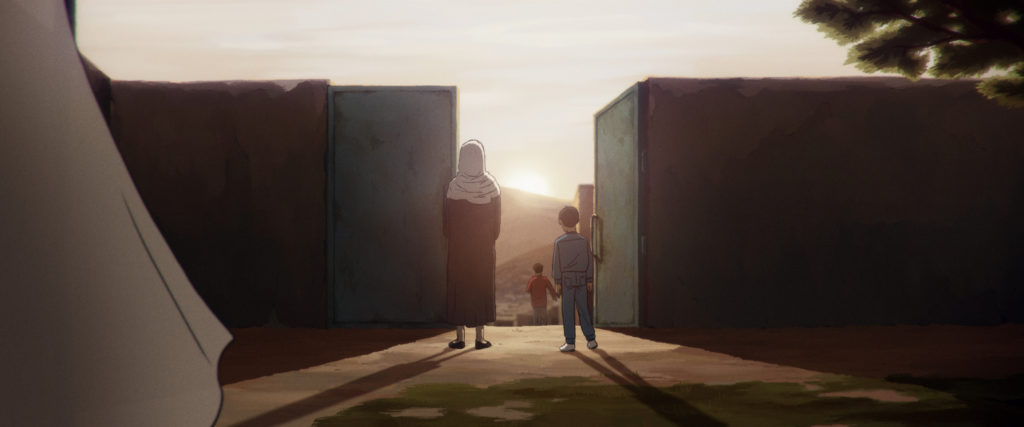
Metzker’s photographs of pedestrians and cityscapes capture the isolating nature of urban life. His influence accentuates the alienation that Amin feels, particularly once he lands in Russia, and then again when he arrives alone in Denmark, where Flee’s palette grows darker. Melancholy grays engulf the frame, contrasting with the light-saturated brilliance of his youth in Afghanistan. Gronsky’s influence is obviously most evident in the mid-section of the film that explores Amin’s life in Russia. The photographer’s work accentuates the stark poverty of the Russian landscape, where cold and impersonal high-rises offer shelter to people amid the barren industrial scenery, but also a sense of foreboding. The land provides nowhere to hide, nor does it present a welcoming image of community. Amin’s life in Russia is one of hiding from the police in his dark apartment, or evading them in the streets where they extort, antagonize, rob, and rape people who are discernably different.
Rasmussen adds that extensive visual research helped recreate Amin’s youth, including photographs saved by the family that he could draw upon, trips to archives, and tours retracing Amin’s steps. “I was supposed to go to Afghanistan, but two weeks before, the hotel I was going to stay at was bombed,” he explains. “The embassy called me and said going there was a bad idea, but I went to Moscow to see where Amin lived, took photos, and did a lot of research. I also went to Estonia where he was imprisoned for six months.”
Evidence of this archival research punctuates Flee as newsreels further root the animation in reality. Archival footage shows fleeting images of life in Afghanistan before Amin’s father was killed and his family’s life upended. Gripping news footage recounts the ordeal in which his sisters were among the refugees stranded in a container ship and were lucky to survive—an ordeal that Amin’s family watched in horror from Russia as they awaited their turn. The archives demonstrate the terrible conditions in which Amin lived in Estonia when their boat was intercepted by immigration authorities. The contrast between the animated recollections and stark actuality footage offers sobering evidence of the conditions one endures along such a journey.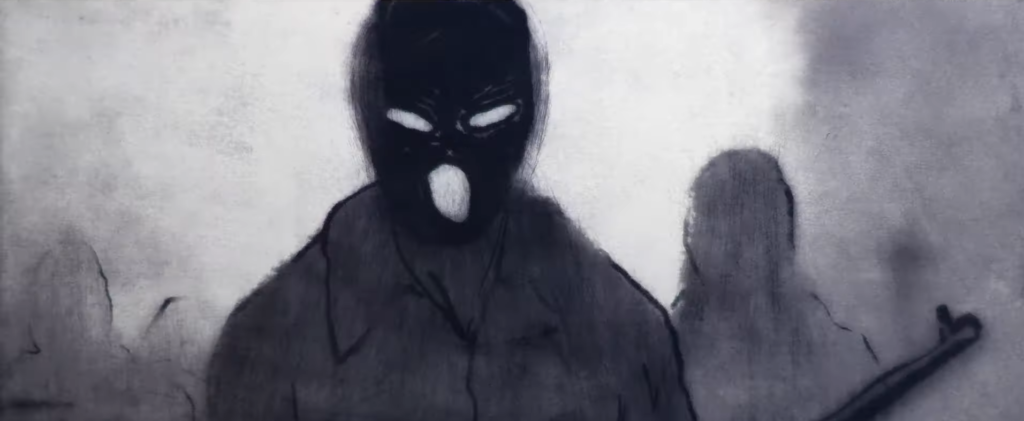
Flee’s design actually lets viewers into Amin’s headspace via the animation, as some of the most painful moments pull us back from the naturalistic animation. “You can tell in his voice when things are hard to talk about,” notes Rasmussen, at which point “we would change the animation.”
These powerful scenes effectively conjure chaos. For example, when Amin recalls his harrowing walk in which traffickers guided his family out of the country and hustled slower refugees along at gunpoint, Rasmussen conveys the journey in sober visuals: gray, matter-of-fact images capture the terrifying ordeal. However, once the group arrives at a rickety boat that will transport them to Russia, Amin shuts his eyes and Flee goes dark. A maelstrom of surreal graphics invite one to imagine the terrifying hell of the ride, conveying in emotions what cannot be captured in images from the belly of the boat.
While Flee is a migration story, it’s also a coming-out tale as Amin’s sexuality compounds his sense of isolation. Flee offers revelatory humour and joy as Amin recalls moments of awakening. These include childhood memories of getting hot while watching action movies or longingly eyeing the Jean Claude Van Damme poster on his bedroom wall.
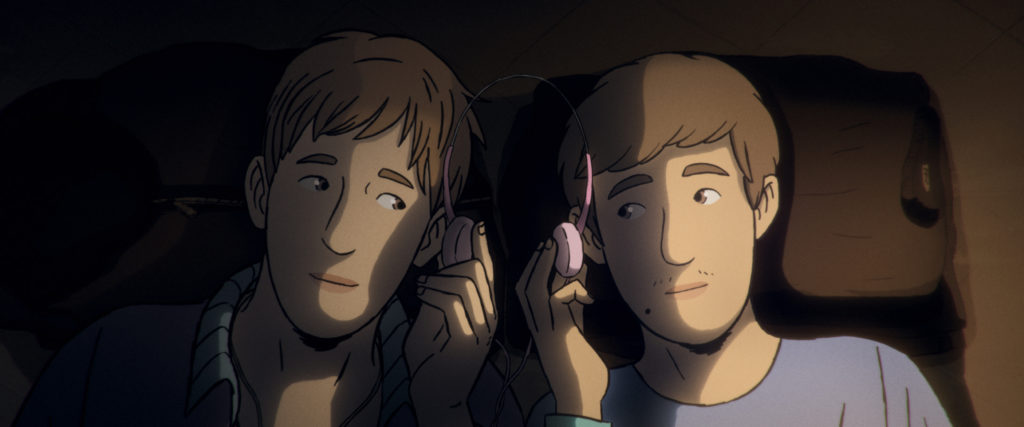
Even a fateful ride with a human trafficker while fleeing Russia leaves Amin with a formative experience. He tells Rasmussen how, lying in a van beside an older boy with hunky shoulders and a golden chain that drew his eyes to the young man’s well-toned chest, he found eye-opening euphoria in the darkest of places. The fellow refugee clasps his chain around Amin’s neck, offering a memento of their life-altering ride together, and shares his headphones as music connects them through intimate escapism.
In this moment, Flee captures Amin’s journey from confusion to jubilation. Despite the deadly silence on which their trafficker insists, Amin’s heart soars as Roxette’s “Joyride” rocks on the soundtrack. He laughs in the interview as he looks back upon his awkwardness and naiveté, but finds a poignant endnote to his account as he tells Rasmussen that he has no idea what happened to the young man he knew in such a brief but defining moment of his life.
Amin’s present-day relationship with his boyfriend, Kasper, underscores how greatly he internalises flight. Rasmussen observes that Amin struggles to stay rooted with Kasper, choosing a job overseas when Kasper wants to settle down. Kasper tries to keep Amin grounded by finding a home together, which leaves him uneasy.

“Being a migrant means losing your home and trying to find a new one, so the story about Amin and his boyfriend trying to find a new home felt very natural to incorporate in his refugee story,” explains Rasmussen. “I think it helped that he was finally telling his story, because the thing about having secrets is that they create distance between people. Amin said that to me afterwards that he always had to keep people at a distance. But now, because the story is out, he feels he can talk more freely, open up, and doesn’t need to feel afraid.”
As Flee proves palpably therapeutic for Amin, the film ultimately becomes a doc about the freeing power of storytelling. Amin’s ability to own his narrative in his own voice and his own words is the foundation upon which Rasmussen creates the profound odyssey. “Trying to find truth in a film, even in media, is difficult. Everything is told through a lens somehow,” observes Rasmussen.
“Flee is Amin’s story seen through my lens. Someone else could tell it another way. Someone else who experienced Amin’s story could tell it in a way other than Amin would tell it.” It might protect his friend, but the animation is arguably a cloak that can save lives by letting audiences experience the personal and political elements of Amin’s story as a refugee, as a gay man, and as someone who can’t stop feeling like an outsider. “Sometimes finding these tools can really crack open a story in a way that’s really beneficial, not only for the filmmaker and audience, but also for the subject of the film,” observes Rasmussen.
Flee opens in select theatres including TIFF Lightbox on Dec. 17.




